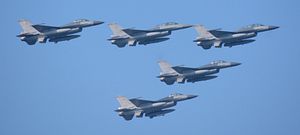Already denied F-16C/D combat aircraft it has sought to acquire for years, Taiwan could now be the unintended victim of “very tough” budgetary decisions by the U.S. Air Force that run the risk of derailing a $5.3 billion retrofit program for the island’s 146 F-16A/B aircraft, according to recent reports that are now being disputed.
Articles published earlier this week citing unnamed U.S. Air Force sources have claimed that the Pentagon’s FY 2015 budget proposal, to be submitted to Congress on March 4, could cut funding for a planned combat avionics programmed extension suite (CAPES) for 300 USAF F-16C/D aircraft and instead allocate funds for a less ambitious service-life extension program (SLEP).
Sources say that the move, which reportedly has received support from some members of the USAF who favor larger allocations of money for fifth-generation aircraft, could delay or perhaps even derail the planned upgrade of Taiwan’s 146 F-16s (and possibly 60 F-16s in the Singaporean Air Force), which stood to benefit from the economy of scale generated by the CAPES program.
Notification of the $5.3 billion retrofit program for Taiwan’s F-16s was sent to the U.S. Congress in January 2010, with Lockheed Martin and Taiwan’s Aerospace Industrial Development Corp (AIDC) cooperating on systems integration. Taipei’s decision to award the upgrade contract to Lockheed Martin practically ensured that whatever choices the USAF made for its F-16 upgrade program would also be Taiwan’s, even if this meant higher costs.
One key component of CAPES was the inclusion of active electronically scanned array (AESA) radar suites for the aircraft, which would substantially improve the aircraft’s detection, targeting and tracking capabilities. After months of speculation, the USAF chose Northrop Grumman’s scalable agile beam radar (SABR) over the Raytheon Advanced Combat Radar (RACR), and by default, Taiwan opted for the SABR system.
With funding for CAPES now possibly in jeopardy, some analysts and media outlets have warned that Taiwan’s Air Force, which is already losing ground to the People’s Liberation Army Air Force (PLAAF), faces a “crisis.” Aside from likely delays, one possible consequence of the U.S. decision could be higher costs for the upgrade package, at a time when the Taiwanese military faces serious budgetary constraints amid efforts to end conscription and as much as $13 billion in backlog requirements for arms deliveries from the U.S.
However, not everybody agrees that the sky is falling for Taiwan’s Air Force. Asked to comment on the matter on February 5, Taiwan’s Ministry of National Defense said it had spoken with its counterparts in the USAF and been assured that the upgrade program was still on track and would not be affected.
Moreover, in a press release issued on May 5, the U.S.-Taiwan Business Council, which plays a role in U.S. arms sales to Taiwan, said it believed the reports on the potential effects of the CAPES decision on the Taiwan retrofit program were inaccurate. “Should this defunding occur, it will have no impact on the schedule or cost for Taiwan’s extensive upgrade program, including on the development of the Active Electronically Scanned Array (AESA) radar,” it wrote.
“The Council understands that the U.S. Air Force remains fully committed to the Taiwan F-16 upgrade program, and that their assurances are reflected in the signed Letter of Offer and Acceptance (LOA),” the Council said. “That commitment ensures that the cost and schedule put in place by the LOA remains, and that the Taiwan military will not see any changes to their program even if the CAPES program is altered. This extends through the upgrade and into the sustainment of the upgraded equipment.”
While the full ramifications of the proposed USAF budget for Taiwan’s upgrade program have yet to be fully understood, we can also expect that Lockheed Martin, Northrop Grumman and other contractors will engage in major lobbying efforts with the USAF and Congress to make sure that the lucrative deal goes through.
In the event, unlikely according to the Council, that the USAF proceeds with nixing CAPES in a way that negatively affects the Taiwan program, one possible way out for Taipei would be to go South Korea’s way by giving the contract to BAE Systems and using the RACR AESA — in other words, Taipei could do what some industry sources told this author it should have done long ago and decouple its project decision from those of the USAF. (South Korea is upgrading 134 KF-16C/D aircraft.) The same sources argued that BAE, which the Taiwanese Air Force never seriously considered for the F-16 upgrade program, was fully capable of doing the work for a fraction of the cost.
Another option, albeit a less appealing one, would be for Taiwan and Singapore to share the costs under CAPES despite the USAF cancellation, though analysts point out that the costs could still be prohibitive for the two Asian countries.
It’s too soon to argue that a decision to scrap CAPES for the USAF F-16s would doom Taiwan’s air force modernization program. Regardless of the outcome, the latest development is another reminder that it is perhaps unwise for the democratic island to rely solely on the U.S. for its defense capabilities.

































